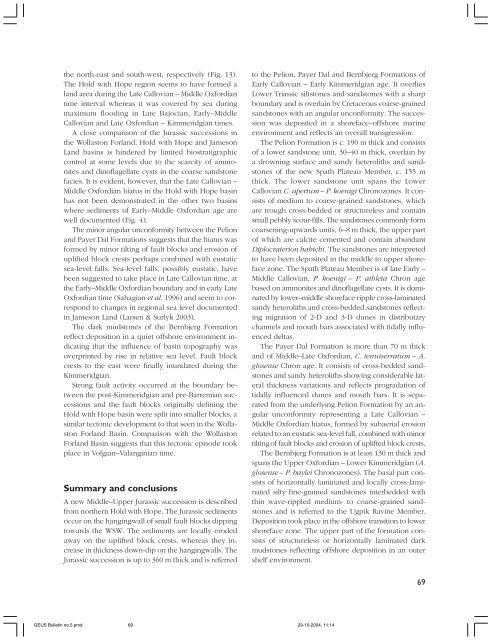GEUS Bulletin no 5.pmd
GEUS Bulletin no 5.pmd
GEUS Bulletin no 5.pmd
Create successful ePaper yourself
Turn your PDF publications into a flip-book with our unique Google optimized e-Paper software.
the <strong>no</strong>rth-east and south-west, respectively (Fig. 13).<br />
The Hold with Hope region seems to have formed a<br />
land area during the Late Callovian – Middle Oxfordian<br />
time interval whereas it was covered by sea during<br />
maximum flooding in Late Bajocian, Early–Middle<br />
Callovian and Late Oxfordian – Kimmeridgian times.<br />
A close comparison of the Jurassic successions in<br />
the Wollaston Forland, Hold with Hope and Jameson<br />
Land basins is hindered by limited biostratigraphic<br />
control at some levels due to the scarcity of ammonites<br />
and di<strong>no</strong>flagellate cysts in the coarse sandstone<br />
facies. It is evident, however, that the Late Callovian –<br />
Middle Oxfordian hiatus in the Hold with Hope basin<br />
has <strong>no</strong>t been demonstrated in the other two basins<br />
where sediments of Early–Middle Oxfordian age are<br />
well documented (Fig. 4).<br />
The mi<strong>no</strong>r angular unconformity between the Pelion<br />
and Payer Dal Formations suggests that the hiatus was<br />
formed by mi<strong>no</strong>r tilting of fault blocks and erosion of<br />
uplifted block crests perhaps combined with eustatic<br />
sea-level falls. Sea-level falls, possibly eustatic, have<br />
been suggested to take place in Late Callovian time, at<br />
the Early–Middle Oxfordian boundary and in early Late<br />
Oxfordian time (Sahagian et al. 1996) and seem to correspond<br />
to changes in regional sea level documented<br />
in Jameson Land (Larsen & Surlyk 2003).<br />
The dark mudstones of the Bernbjerg Formation<br />
reflect deposition in a quiet offshore environment indicating<br />
that the influence of basin topography was<br />
overprinted by rise in relative sea level. Fault block<br />
crests to the east were finally inundated during the<br />
Kimmeridgian.<br />
Strong fault activity occurred at the boundary between<br />
the post-Kimmeridgian and pre-Barremian successions<br />
and the fault blocks originally defining the<br />
Hold with Hope basin were split into smaller blocks, a<br />
similar tectonic development to that seen in the Wollaston<br />
Forland Basin. Comparison with the Wollaston<br />
Forland Basin suggests that this tectonic episode took<br />
place in Volgian–Valanginian time.<br />
Summary and conclusions<br />
A new Middle–Upper Jurassic succession is described<br />
from <strong>no</strong>rthern Hold with Hope. The Jurassic sediments<br />
occur on the hangingwall of small fault blocks dipping<br />
towards the WSW. The sediments are locally eroded<br />
away on the uplifted block crests, whereas they increase<br />
in thickness down-dip on the hangingwalls. The<br />
Jurassic succession is up to 360 m thick and is referred<br />
<strong>GEUS</strong> <strong>Bulletin</strong> <strong>no</strong> <strong>5.pmd</strong> 69<br />
29-10-2004, 11:14<br />
to the Pelion, Payer Dal and Bernbjerg Formations of<br />
Early Callovian – Early Kimmeridgian age. It overlies<br />
Lower Triassic siltstones and sandstones with a sharp<br />
boundary and is overlain by Cretaceous coarse-grained<br />
sandstones with an angular unconformity. The succession<br />
was deposited in a shoreface–offshore marine<br />
environment and reflects an overall transgression.<br />
The Pelion Formation is c. 190 m thick and consists<br />
of a lower sandstone unit, 30–40 m thick, overlain by<br />
a drowning surface and sandy heteroliths and sandstones<br />
of the new Spath Plateau Member, c. 155 m<br />
thick. The lower sandstone unit spans the Lower<br />
Callovian C. apertum – P. koenigi Chro<strong>no</strong>zones. It consists<br />
of medium to coarse-grained sandstones, which<br />
are trough cross-bedded or structureless and contain<br />
small pebbly scour-fills. The sandstones commonly form<br />
coarsening-upwards units, 6–8 m thick, the upper part<br />
of which are calcite cemented and contain abundant<br />
Diplocraterion habichi. The sandstones are interpreted<br />
to have been deposited in the middle to upper shoreface<br />
zone. The Spath Plateau Member is of late Early –<br />
Middle Callovian, P. koenigi – P. athleta Chron age<br />
based on ammonites and di<strong>no</strong>flagellate cysts. It is dominated<br />
by lower–middle shoreface ripple cross-laminated<br />
sandy heteroliths and cross-bedded sandstones reflecting<br />
migration of 2-D and 3-D dunes in distributary<br />
channels and mouth bars associated with tidally influenced<br />
deltas.<br />
The Payer Dal Formation is more than 70 m thick<br />
and of Middle–Late Oxfordian, C. tenuiserratum – A.<br />
glosense Chron age. It consists of cross-bedded sandstones<br />
and sandy heteroliths showing considerable lateral<br />
thickness variations and reflects progradation of<br />
tidally influenced dunes and mouth bars. It is separated<br />
from the underlying Pelion Formation by an angular<br />
unconformity representing a Late Callovian –<br />
Middle Oxfordian hiatus, formed by subaerial erosion<br />
related to an eustatic sea-level fall, combined with mi<strong>no</strong>r<br />
tilting of fault blocks and erosion of uplifted block crests.<br />
The Bernbjerg Formation is at least 130 m thick and<br />
spans the Upper Oxfordian – Lower Kimmeridgian (A.<br />
glosense – P. baylei Chro<strong>no</strong>zones). The basal part consists<br />
of horizontally laminated and locally cross-laminated<br />
silty fine-grained sandstones interbedded with<br />
thin wave-rippled medium- to coarse-grained sandstones<br />
and is referred to the Ugpik Ravine Member.<br />
Deposition took place in the offshore transition to lower<br />
shoreface zone. The upper part of the formation consists<br />
of structureless or horizontally laminated dark<br />
mudstones reflecting offshore deposition in an outer<br />
shelf environment.<br />
69

















